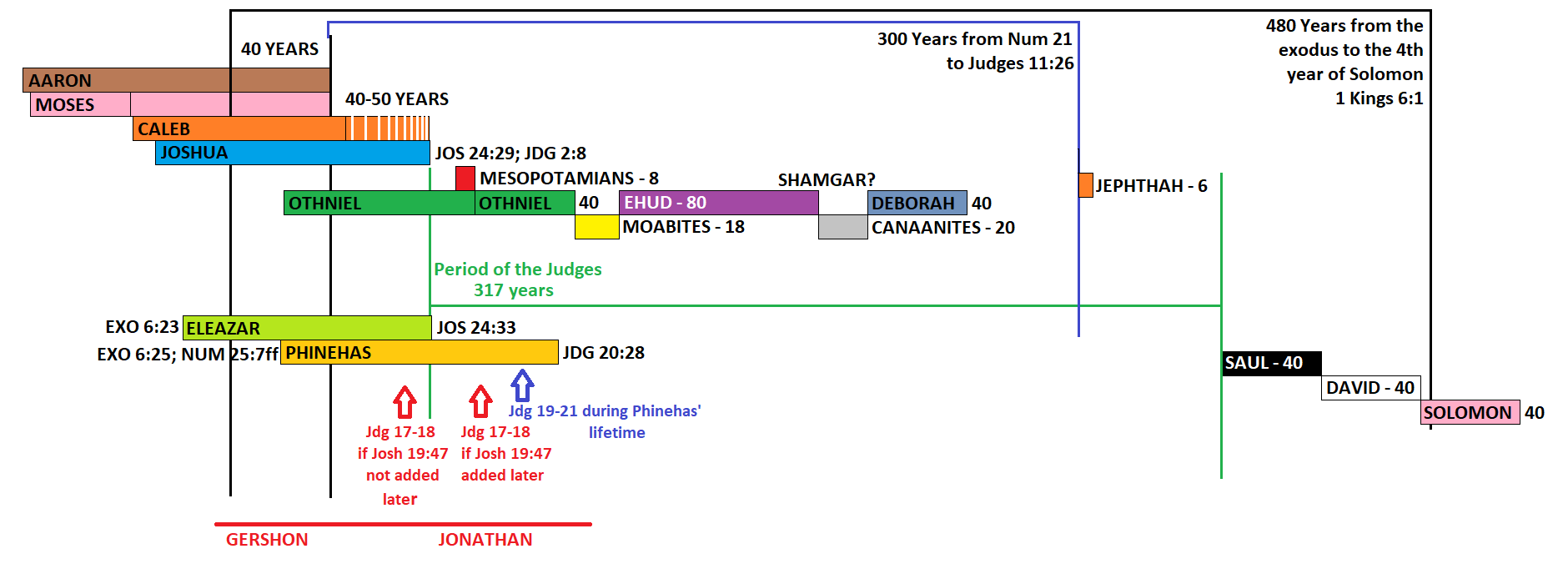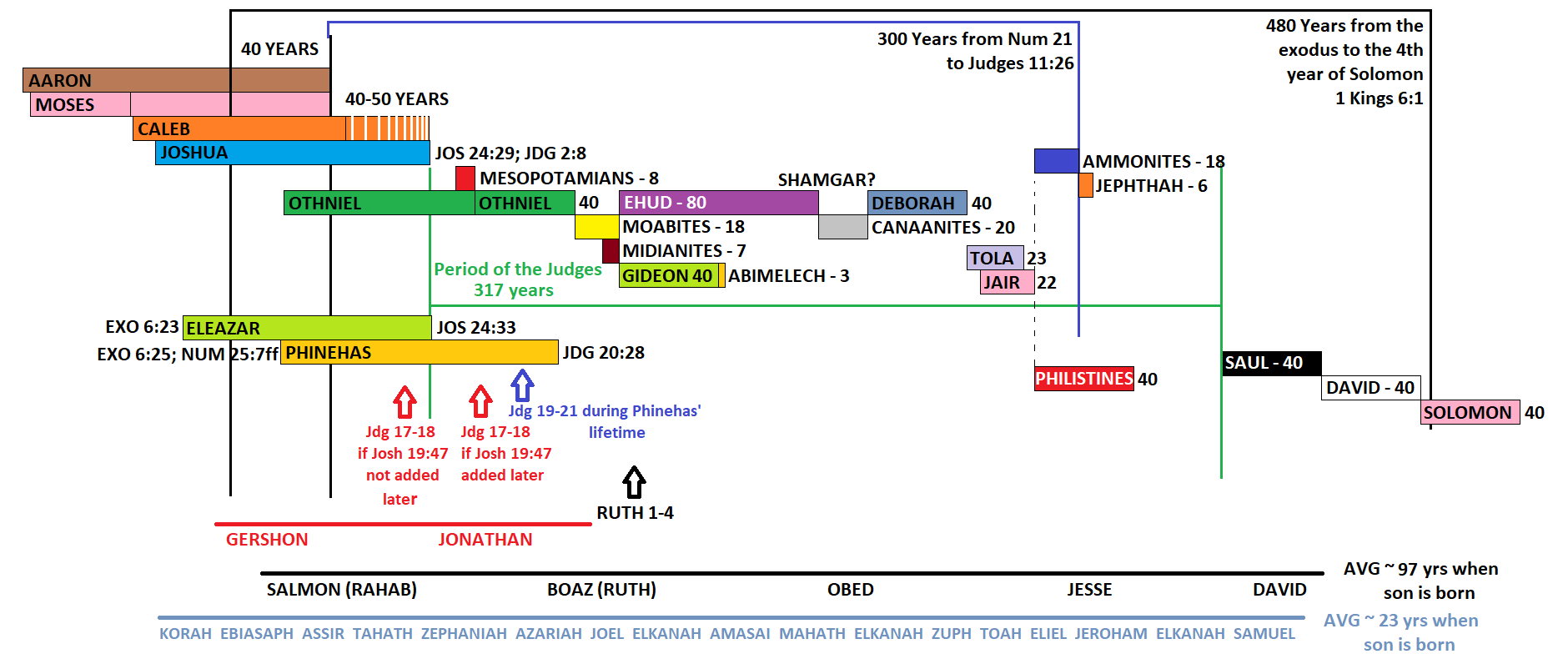War with Benjamin (Judges 19-21)
Here is the reason for considering the age of Phinehas in our timeline. Phinehas was serving as high priest after his father Eleazar died at the end of Joshua. He was already in his 60s by this time, assuming he was 20 when he killed Zimri and Cozbi (Num. 25). It is unlikely he lived more than 58 years later (10 years after Joshua + 8 years of Mesopotamian oppression + 40 years of Othniel as judge), so it seems likely that this, too, occurred during Othniel’s time as judge.
These events nearly destroyed the tribe of Benjamin, reducing them down to 600 men. Seven hundred of Benjamin’s soldiers, ironically enough, were all left-handed in the special forces (Judges 20:15-16). Ehud, the judge to follow Othniel and Moabite oppression, was a left-handed Benjamite. He was the hero of Israel several years after his tribe was demolished. Since his judgeship lasted 80 years, it is likely that he was not among the soldiers of Benjamin who fought against the rest of Israel, but one of their sons. Knowing how the 600 Benjamites obtained wives after they were demolished, we recognize an unpleasant reality.
Fig. 4 – Below is the timeline for Judges 17-21 including Dan’s Migration and the War with Benjamin. To help with timing Dan’s Migration, I have the lineage of Jonathan, grandson of Moses. Gershon was not too old when Moses went back to Egypt, and Jonathan was a young man in Judges 17-18. The War with Benjamin (Judges 19-21) had to be in the lifetime of Aaron’s grandson Phinehas (Judges 20:28). Included are the first three oppressions and judges.
Ruth
Many people will try to place the events of Ruth toward the end of the period of the judges based on the genealogy presented at the end of the book: Perez → Hezron → Ram → Amminadab → Nahshon → Salmon → Boaz → Obed → Jesse → David (Ruth 4:18-22). David is only three generations removed from Boaz, Ruth’s husband. But they seem to ignore that Perez and Hezron both entered into Egypt with Jacob and Judah (Genesis 46:12), that Nahshon was the leader of Judah during the exodus (Numbers 2:3), and Salmon married Rahab (Matthew 1:5). It seems clear that Boaz was one generation removed from Joshua’s conquest of Canaan. One might say that some people could be skipped in such genealogies, which is a fair point. But this genealogy is confirmed in 1 Chronicles 2:9-15 and in Matthew 1:3-6. Matthew may have skipped over a few people, but given how exhaustive the Chronicles is elsewhere, it seems unlikely that Ezra (the traditional author of Chronicles) did. The average age of a father when a child was born in this lineage is about 97 years old. Given the ages of a lot of men in the Bible when their children are born, this is not unusual. This is corroborated in 1 Samuel 17:12 when it describes Jesse as “old, advanced in years.” Plus, older men marrying much younger women was commonplace back then. It is also possible that Ruth was barren for a long time before Obed was born (Ruth 4:13). By contrast, the lineage of Samuel given in 1 Chronicles 6:33-38 from Korah to Samuel leaves an average age of 23 for each father when his child is born.
The beginning of Ruth depicts a famine as the reason for Elimelech leaving his home in Bethlehem with his wife Naomi and two sons and going to Moab. In Moab, their sons find and marry Moabite women, one being the titular Ruth. The only famine mentioned in the Book of Judges is in Judges 6 accompanying the Midianite oppression. If we take the periods in Judges consecutively, then the Midianite oppression ended 263 years after Rahab is introduced in Joshua 2. This is far too late. Steve Rudd (bible.ca) suggests there was an unmentioned famine during the Moabite oppression in Judges 3. This does fit the timeline a little better, with the Moabite oppression ending 116 years after Joshua 2. I want to suggest that the Moabite oppression and the Midianite oppression are concurrent events, making Ehud and Gideon contemporaries working in different parts of Israel.
There are some areas where this theory seems to fit and areas where it doesn’t. Areas that seem to work:
The periods of oppression are not conducted by only one nation. The Moabite oppression includes the Ammonites and the Amalekites—only King Eglon of Moab takes center stage when Ehud shows up.
The Moabites and the Midianites have been known to team up before, such as under Balak while the Israelites are on the Plains of Moab about to enter the Promised Land.
The Midianite oppression was also not conducted alone, but included the Amalekites and the “people of the East.” The Midianites take center stage, probably because they are Ishmaelites with earrings, which were used in Gideon’s golden ephod (Judges 8:24-27). Whatever the case, Moab and Ammon are to the east, and this could be referring to them.
There is no definite time statement telling us when the events of Gideon occur in relation to the earlier mentioned judges, so it’s possible. It is unlikely around the time of Deborah, however, since the events surrounding her and Barak occur in close geographical proximity to the events surrounding Gideon.
But there are some concerns about this theory:
There is no indication anywhere other than circumstantial evidence that this is true.
It appears that Gideon comes after Deborah in the narrative, even though we know not all the judges are consecutive.
There is about a 27-year gap between the end of Deborah’s period of rest and the beginning of Ammonite/Philistine oppression in Judges 10:6-9; 13:1. I suggest putting Tola and Jair there, and since they are in different locations, their judgeships can overlap, but again, see #1 and #2 concerning these objections.
Whatever the case, this seems to solve the problem of when the events of Ruth occur, where the famine came from, and how to fit all the judges into ~300 years.
Fig. 5 – The placement of Ruth is shown here in the contemporary judgeships of Ehud and Gideon. Abimelech, Tola, and Jair are included, along with the oppressions of the Ammonites and the Philistines. The genealogy from Salmon to David is shown to give placement to Boaz/Ruth. The contrasting genealogy from Korah to Samuel (1 Chron. 6:33-38) is shown as well. Korah was killed in Numbers 16, and Samuel was the final judge who lived until 1 Samuel 25:1.

